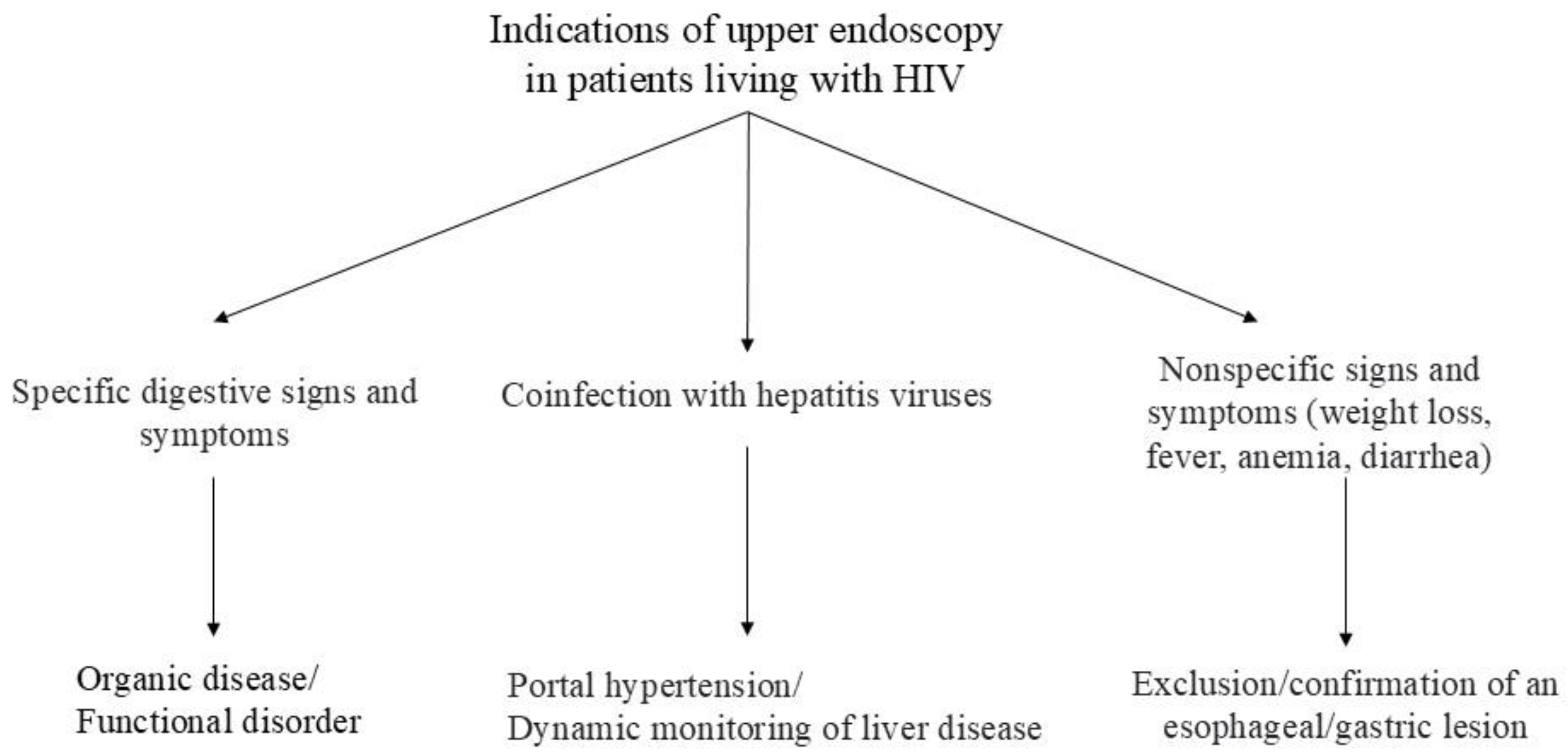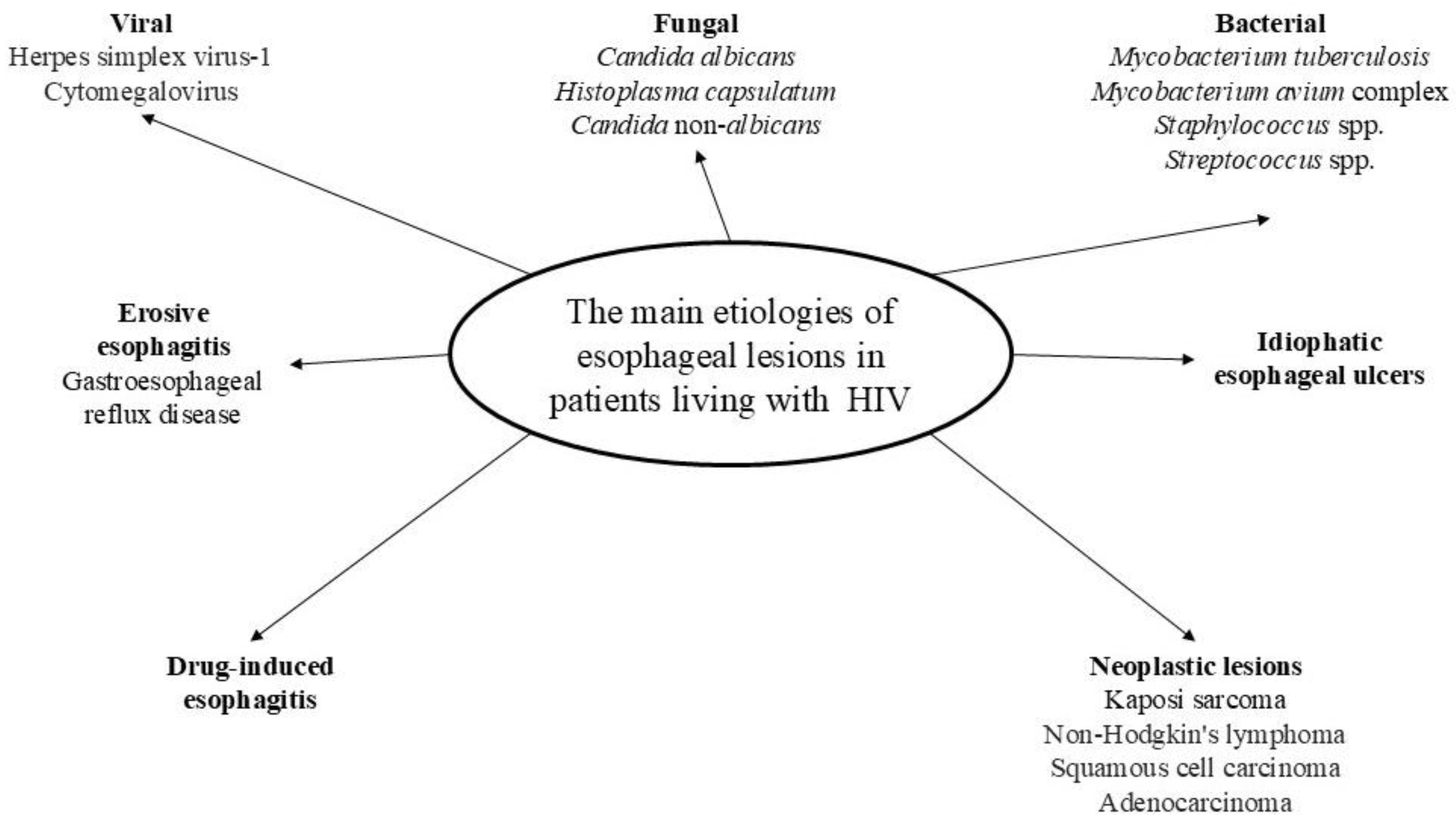The Spectrum of Esophagitis in Patients Living with HIV—A Scoping Review
Abstract
Introduction
Predictive factors in the occurrence of esophagitis
Main types of esophageal lesions in patients living with HIV
Fungal causes of esophagitis
Candida esophagitis.
Other fungal causes of esophagitis
Viral causes of esophagitis
Herpetic esophagitis
Cytomegalovirus esophagitis
Bacterial esophagitis
Neoplastic lesions
Other causes of esophageal lesions
Idiopathic esophageal ulcers
Esophageal strictures
Gastroesophageal reflux disease
Drug-induced esophagitis
Conclusions
Author Contributions
Funding
Conflicts of Interest
References
- World Health Organization. HIV statistics, globally and by WHO region, 2024; WHO: Geneva, Switzerland, 2024. [Google Scholar]
- European Centre for Disease Prevention and Control, World Health Organization European Region. HIV/AIDS surveillance in Europe 2023 (2022 data): ECDC; WHO European Region, 2023. [Google Scholar]
- Hanson, D.L.; Chu, S.Y.; Farizo, K.M.; Ward, J.W. Distribution of CD4+ T lymphocytes at diagnosis of acquired immunodeficiency syndrome-defining and other human immunodeficiency virus-related illnesses. The Adult and Adolescent Spectrum of HIV Disease Project Group. Arch. Intern. Med. 1995, 155, 1537–1542. [Google Scholar] [CrossRef] [PubMed]
- Lopez-Dupla, M.; Mora Sanz, P.; Pintado Garcia, V.; et al. Clinical, endoscopic, immunologic, and therapeutic aspects of oropharyngeal and esophageal candidiasis in HIV-infected patients: A survey of 114 cases. Am. J. Gastroenterol. 1992, 87, 1771–1776. [Google Scholar] [PubMed]
- Takahashi, Y.; Nagata, N.; Shimbo, T.; et al. Long-term trends in esophageal candidiasis prevalence and associated risk factors with or without HIV infection: Lessons from an endoscopic study of 80,219 patients. PLoS ONE 2015, 10, e0133589. [Google Scholar] [CrossRef]
- Bonacini, M.; Young, T.; Laine, L. The causes of esophageal symptoms in human immunodeficiency virus infection. A prospective study of 110 patients. Arch. Intern. Med. 1991, 151, 1567–1572. [Google Scholar] [CrossRef]
- Olariu, M.; Vasilescu, I.; Nurciu, A.; et al. The utility of upper digestive endoscopy in the evaluation of HIV patients with low CD4+ T-lymphocyte values. Arch. Balkan Med. Union. 2019, 54, 612–620. [Google Scholar] [CrossRef]
- Mastroianni, A.; Cancellieri, C.; Coronado, O.; Manfredi, R.; Chiodo, F.; Pignatari, S. Bacterial esophagitis in patients with HIV disease. Infez. Med. 1999, 7, 192–194. [Google Scholar]
- Mohamed, A.A.; Lu, X.L.; Mounmin, F.A. Diagnosis and treatment of esophageal candidiasis: Current updates. Can. J. Gastroenterol. Hepatol. 2019, 2019, 3585136. [Google Scholar] [CrossRef]
- Daniell, H.W. Acid suppressing therapy as a risk factor for Candida esophagitis. Dis. Esophagus. 2016, 29, 479–483. [Google Scholar] [CrossRef]
- Nishimura, S.; Nagata, N.; Shimbo, T.; et al. Factors associated with esophageal candidiasis and its endoscopic severity in the era of antiretroviral therapy. PLoS ONE 2013, 8, e58217. [Google Scholar] [CrossRef]
- Bini, E.J.; Micale, P.L.; Weinshel, E.H. Natural history of HIV-associated esophageal disease in the era of protease inhibitor therapy. Dig. Dis. Sci. 2000, 45, 1301–1307. [Google Scholar] [CrossRef] [PubMed]
- Takahashi, Y.; Nagata, N.; Shimbo, T.; et al. Upper gastrointestinal symptoms predictive of Candida esophagitis and erosive esophagitis in HIV and non-HIV patients: An endoscopy-based cross-sectional study of 6011 patients. Medicine 2015, 94, e2138. [Google Scholar] [CrossRef]
- Wilson, A.; Delport, J.; Ponich, T. Candida glabrata esophagitis: Are we seeing the emergence of a new azoleresistant pathogen? Int. J. Microbiol. 2014, 2014, 371631. [Google Scholar] [CrossRef] [PubMed]
- Sousa, B.R.; Freitas, J.F.; Valeriano, C.A.; et al. Refractory esophagitis caused by Candida nivariensis: Second description of this yeast in Brazil and a literature review. Future Microbiol. 2022, 17, 903–915. [Google Scholar] [CrossRef]
- Mandavdhare, H.S.; Shah, J.; Prasad, K.K.; et al. Gastrointestinal histoplasmosis: A case series from a nonendemic region in North India. Intest. Res. 2019, 17, 14952. [Google Scholar] [CrossRef] [PubMed]
- Canalejo, E.; Garcia Duran, F.; Cabello, N. Garcia Martinez Herpes esophagitis in healthy adults and adolescents: Report of 3 cases and review of the literature. Medicine 2010, 89, 204–210. [Google Scholar] [CrossRef]
- Hopkins, C.; Bansari, A.; Ladna, M.; Dideban, B. Prolonged intractable hiccups associated with HSV (I&II) esophagitis and H. pylori gastritis. Case Rep. Infect. Dis. 2023, 2023, 3561895. [Google Scholar] [CrossRef]
- Wilcox, C.M.; Rodgers, W.; Lazenby, A. Prospective comparison of brush cytology, viral culture, and histology for the diagnosis of ulcerative esophagitis in AIDS. Clin. Gastroenterol. Hepatol. 2004, 2, 564–567. [Google Scholar] [CrossRef] [PubMed]
- Gallant, J.E.; Moore, R.D.; Richman, D.D.; Keruly, J.; Chaisson, R.E. Incidence and natural history of cytomegalovirus disease in patients with advanced human immunodeficiency virus disease treated with zidovudine. The Zidovudine Epidemiology Study Group. Infect. Dis. 1992, 166, 1223–1227. [Google Scholar] [CrossRef]
- Yust, I.; Fox, Z.; Burke, M.; et al. Retinal and extraocular cytomegalovirus end-organ disease in HIV-infected patients in Europe: A EuroSIDA study, 1994-2001. Eur J Clin Microbiol Infect Dis. 2004, 23, 550–559. [Google Scholar] [CrossRef]
- Ali, A.; Sanders, K.; McCarthy, A.; et al. Infective esophagitis: A review of esophageal diseases in HIV. Curr. Treat. Options Gastroenterol. 2024, 22, 1–14. [Google Scholar] [CrossRef]
- Sharma, D.D.; Girgis, P.; Gandhi, D.; et al. Contemporary insights into HIV esophagitis: Pathogenesis, therapeutic strategies, and prognostic outcomes. Cureus 2024, 16, e60788. [Google Scholar] [CrossRef]
- Mremi, A.; Mswima, J.; Mlay, M.G.; et al. Cancer spectrum in HIV-infected patients: A zonal hospital experience in Tanzania. Cancer Treat. Res. Commun. 2020, 25, 100213. [Google Scholar] [CrossRef]
- Thrift, A.P.; Kramer, J.R.; Hartman, C.M.; et al. Risk and predictors of esophageal and stomach cancers in HIVinfected veterans: A matched cohort study. J. Acquir. Immune Defic. Syndr. 2019, 81, e65–e72. [Google Scholar] [CrossRef]
- Lv, B.; Cheng, X.; Gao, J.; et al. Human immunodeficiency virus (HIV) is highly associated with giant idiopathic esophageal ulcers in acquired immunodeficiency syndrome (AIDS) patients. Am. J. Transl. Res. 2016, 8, 4464–4471. [Google Scholar] [PubMed]
- Wilcox, C.M. Esophageal strictures complicating ulcerative esophagitis in patients with AIDS. Am. J. Gastroenterol. 1999, 94, 339–343. [Google Scholar] [CrossRef] [PubMed]
- Abdi, S.; Masbough, F.; Nazari, M.; Abbasinazari, M. Druginduced esophagitis and helpful management for healthcare providers. Gastroenterol. Hepatol. Bed Bench. 2022, 15, 219–224. [Google Scholar] [PubMed]
- Nkuize, M.; De Wit, S.; Muls, V.; Arvanitakis, M.; Buset, M. Upper gastrointestinal endoscopic findings in the era of highly active antiretroviral therapy. HIV Med. 2010, 11, 412–417. [Google Scholar] [CrossRef]
- Saleem, F.; Sharma, A. Drug-induced esophagitis; StatPearls: Treasure Island, FL, USA, 2023. [Google Scholar]

© GERMS 2025.
Share and Cite
Olariu, M.C.; Olariu, M.H.; Iancu, A.M.; Săndulescu, O.; Streinu-Cercel, A.; Barbu, E.C.; Şahin, G.Ö.; Borcan, A.M.; Cruceru, M.M.; Simoiu, M.; et al. The Spectrum of Esophagitis in Patients Living with HIV—A Scoping Review. GERMS 2024, 14, 188-196. https://doi.org/10.18683/germs.2024.1430
Olariu MC, Olariu MH, Iancu AM, Săndulescu O, Streinu-Cercel A, Barbu EC, Şahin GÖ, Borcan AM, Cruceru MM, Simoiu M, et al. The Spectrum of Esophagitis in Patients Living with HIV—A Scoping Review. GERMS. 2024; 14(2):188-196. https://doi.org/10.18683/germs.2024.1430
Chicago/Turabian StyleOlariu, Mihaela Cristina, Mihai Hristu Olariu, Adela Mihaela Iancu, Oana Săndulescu, Anca Streinu-Cercel, Ecaterina Constanţa Barbu, Gülşen Özkaya Şahin, Alina Maria Borcan, Miruna Maria Cruceru, Mădălina Simoiu, and et al. 2024. "The Spectrum of Esophagitis in Patients Living with HIV—A Scoping Review" GERMS 14, no. 2: 188-196. https://doi.org/10.18683/germs.2024.1430
APA StyleOlariu, M. C., Olariu, M. H., Iancu, A. M., Săndulescu, O., Streinu-Cercel, A., Barbu, E. C., Şahin, G. Ö., Borcan, A. M., Cruceru, M. M., Simoiu, M., & on behalf of ESCMID Study Group for Viral Hepatitis. (2024). The Spectrum of Esophagitis in Patients Living with HIV—A Scoping Review. GERMS, 14(2), 188-196. https://doi.org/10.18683/germs.2024.1430




